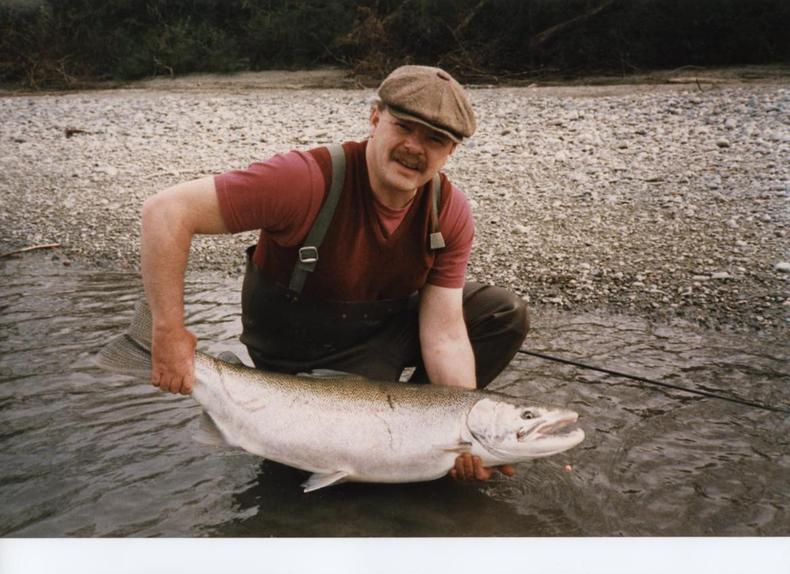Saving What's Left
Fishing for Crumbs
Many folks in my community find meaning in the outdoors. There is a convergence of passion for a particular activity with the benefits to the individual and to the natural world. We can't ski the backcountry without open space. We can't run rivers if they are dammed. And we can't live our lives in balance if we don't have open places to stretch our legs and our eyes.
It just so happens that being passionate about steelhead carries with it an extra dimension of this convergence. Steelhead are bellwethers of the health of our ecosystems. When they are present, things are still relatively good. Once they are gone, however, society is going to have bigger problems than disgruntled anglers complaining about how good things used to be.
For me and those like me, the stakes are high. Every step backwards, every river closure, every increase in pressure on wild stocks hits me squarely in my fish-loving guts. It will not be possible for me to explain the substantive difference between a hatchery plant and a wild fish if nobody can experience wild fish anymore. Once all the rivers close, I will know, bitterly, what we've lost.
Surely a scenario such as this goes beyond those who fish, though it may pass numbly through headlines as just another symptom of our changing world.
Whether or not you can tell a Coho from a Chinook, the health of the natural world matters. Even if you don't have a recreational habit that depends on healthy fish stocks (I don't recommend it), then at least you can see the significance if you sometimes eat fish. True, we are no longer predators in the traditional sense, linked to our food by skill, effort and reward. But the same problems that are threatening wild fish are also at the heart of causes many of us care about: decreasing quality of life in favor of cheap consumerism and greater inequality.
One of the most pernicious issues facing us is the shifting baseline of what's perceived as natural abundance, and I'd like to address that here.
My time for steelhead, the amazing freedom I had in the spring of 2015 in order to chase steelhead—this freedom is simply what every Washington angler had in his backyard until basically the late 90's. For the price of admission, the resource was unparalleled, and the drive was much shorter and the runs were much less crowded.
The amount of effort it takes to get on the road at 5:00 AM so I can at least get a decent day in fishing is part of why it’s so hard to find time to steelhead, a difficulty which every angler on the crowded waters of the Olympic Peninsula also undertakes to pursue these incredible gamefish.
Despite recent progress, I fear I am fishing the twilight of steelheading in Washington State.
Let's do a fun little thought experiment. Step into my steelhead time machine!
If I had learned of steelhead in Seattle around the year 2000, I would have at least gotten to fish the legendary spring runs in the Skykomish, a mere 45 min. from my local fly shop, during the catch-and-release season of March and April.
Had I learned in the year 1990, I would have had unrestricted access to all of the S-Rivers, and I would have experienced what I consider to be light fishing pressure and easy access to what I consider an unparalleled wilderness experience.
Here's a pic of shop friend and master storyteller emeritus, Dan Speth, with what I would have been chasing.

Had it been possible for me to chase WA steelhead in the 1980s and before (I was born in December of 1980), I would have experienced days on the river that would overshadow my very best days steelheading, and with more frequency. To boot, I would have been able to choose the rivers I wanted to fish based on aesthetics and run characteristics, whereas right now I must drive five hours to the coastal rivers because they are the only ones that are open. No doubt I would have spent time on the North Fork of the Stillaguamish, a fly-fishing only section of steelhead legend which was set aside by the actions of the Seattle Fly Fishing Club.
Had I this fishing time machine, I could have fished the Skagit in its heyday, instead of its last catch-and-release season where I scratched out my first wild Puget Sound fish before it was closed.
Is it possible that I would have hooked more fish more frequently? Older anglers out there, let me know. My hunch is that steelhead are always hard to come by, but it sure is fun to think about.
Mostly I’m putting up this section of my blog because I think steelhead are really cool, and I want friends and family to know what I did the year before grad school.
But I also hope that anyone who is wondering about spey fishing for steelhead will read this blog. Maybe somebody new to the sport will realize just how rewarding this type of fishing can be, get the bug, chase and capture a fish, and learn more about preserving not only these fish, but our access to them. I barely had the chance to catch WA steelhead, and I know I’ve got the bug. There must be more anglers out there like me.
The tagline below the title is taken from a summary put together some years ago by noted local author Dylan Tomine. I read his work at the time and didn't fully understand it as I just started my time as a steelheader. Some years later, I'm echoing his sentiments exactly.
Watch this video. Check out this site. If you've never heard of steelhead, come take a class from The Avid Angler. And hook a fish on the swing.
A Season For Steelhead, Powder, Waves and Bonefish
